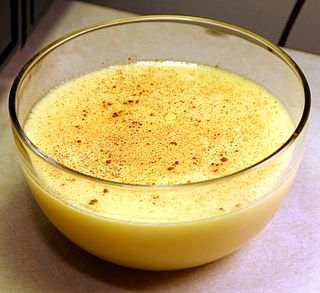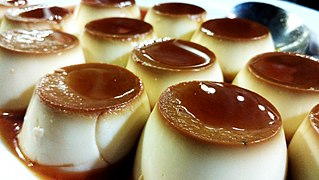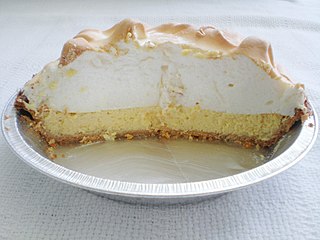
Custard is a variety of culinary preparations based on sweetened milk, cheese, or cream cooked with egg or egg yolk to thicken it, and sometimes also flour, corn starch, or gelatin. Depending on the recipe, custard may vary in consistency from a thin pouring sauce to the thick pastry cream used to fill éclairs. The most common custards are used in custard desserts or dessert sauces and typically include sugar and vanilla; however, savory custards are also found, e.g., in quiche.

Lemon meringue pie is a dessert pie consisting of a shortened pastry base filled with lemon curd and topped with meringue.

flan, flan, caramel pudding, condensed milk pudding or caramel custard is a custard dessert with a layer of clear caramel sauce.

Key lime pie is an American dessert pie. It is made of lime juice, egg yolks, and sweetened condensed milk. It may be served with no topping, topped with a meringue topping made from egg whites, or with whipped cream; it may be cooked in a pie crust, graham cracker crust, or no crust. The dish is named after the small Key limes, which are more aromatic than the common Persian limes, and which have yellow juice. The filling in a Key lime pie is typically yellow because of the egg yolks.

Rice pudding is a dish made from rice mixed with water or milk and other ingredients such as cinnamon, vanilla and raisins.

A cream pie, crème pie, or creme pie is a type of pie filled with a rich custard or pudding that is made from milk, cream, sugar, wheat flour, and eggs. It comes in many forms, including vanilla, lemon, lime, peanut butter, banana, coconut, and chocolate. One feature of most cream pies is a whipped cream topping. The custard filling is related to crème patissière, a key component of French cakes, and tarts. It is a one-crust pie, where the crust covers the bottom and sides but not the top. The crust may be a standard pastry pie crust, or made with crumbled cookies or a graham cracker crust.

Coquito meaning "Little Coconut" in Spanish is a traditional Christmas drink that originated in Puerto Rico. The coconut-based alcoholic beverage is similar to eggnog, and is sometimes referred to as Puerto Rican Eggnog. The mixed drink is made with Puerto Rican rum, coconut milk, cream of coconut, sweetened condensed milk, vanilla, nutmeg, clove, and cinnamon.

Fruit curd is a dessert spread and topping usually made with citrus fruit, such as lemon, lime, orange, grapefruit or tangerine. Other flavor variations include passion fruit, mango, and berries such as raspberries, cranberries or blackberries. The basic ingredients are beaten egg yolks, sugar, fruit juice, and zest, which are gently cooked together until thick and then allowed to cool, forming a soft, smooth, flavorful spread. The egg yolks are usually tempered in the cooking process to prevent their coagulation. Some recipes also include egg whites or butter.

An icebox cake is a dairy-based dessert made with cream, fruits, nuts, and wafers and set in the refrigerator. One particularly well-known version is the back-of-the-box recipe on thin and dark Nabisco Famous Chocolate Wafers.

Buko pie, sometimes anglicized as coconut pie, is a traditional Filipino baked young coconut (malauhog) custard pie. It is considered a specialty in the city of Los Baños, Laguna located on the island of Luzon.

Jumbles are simple butter cookies made with a basic recipe of flour, sugar, eggs, and butter. They can be flavored with vanilla, anise, or caraway seed used for flavoring, or other flavoring can be used like almond. They were formerly often made in the form of rings or rolls.

The poppy seed roll is a pastry consisting of a roll of sweet yeast bread with a dense, rich, bittersweet filling of poppy seed. An alternative filling is a paste of minced walnuts, or minced chestnuts.

Bread and butter pudding is a traditional bread pudding in British cuisine. Slices of buttered bread scattered with raisins are layered in an oven dish, covered with an egg custard mixture seasoned with nutmeg, vanilla, or other spices, then baked.

Sponge cake is a light cake made with egg whites, flour and sugar, sometimes leavened with baking powder. Some sponge cakes do not contain egg yolks, like angel food cake, but most of them do. Sponge cakes, leavened with beaten eggs, originated during the Renaissance, possibly in Spain. The sponge cake is thought to be one of the first of the non-yeasted cakes, and the earliest attested sponge cake recipe in English is found in a book by the English poet Gervase Markham, The English Huswife, Containing the Inward and Outward Virtues Which Ought to Be in a Complete Woman (1615). Still, the cake was much more like a cracker: thin and crispy. Sponge cakes became the cake recognized today when bakers started using beaten eggs as a rising agent in the mid-18th century. The Victorian creation of baking powder by English food manufacturer Alfred Bird in 1843 allowed the addition of butter to the traditional sponge recipe, resulting in the creation of the Victoria sponge. Cakes are available in millions of flavours and have many recipes as well. Sponge cakes have become snack cakes via the Twinkie.

Biscuit cake is a type of no bake tea cake, similar to American icebox cake, found in Irish, English, Danish, Arabic, Bulgarian and Jewish cuisine. It is made with digestive biscuits and is optionally prepared with a chocolate glaze.
Pie in American cuisine has roots in English cuisine and has evolved over centuries to adapt to American cultural tastes and ingredients. The creation of flaky pie crust shortened with lard is credited to American innovation.
Icebox pies are no-bake pies including ice cream pies, chiffon pies, and classic cream pies like key lime pie, lemon ice box pie, chocolate pudding pie, grasshopper pie and banana cream pie. The crust can be a crumb crust or blind baked pastry. They are associated with the cuisine of the Southern United States.
















